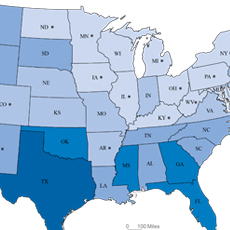Census.gov > Library > Infographics & Visualizations > 2012 > Components of Metro Area Change, 2010-2011
Library
Components of Metro Area Change, 2010-2011
December 6, 2012

Population change can be attributed to several different processes: natural increase (births minus deaths), net domestic migration, and international migration. Many of the largest metro areas lost population through domestic migration. With the exception of the Detroit metro area, those losses were balanced by gains from natural increase and net international migration.
SOURCE: Population Division, Vintage 2011 Population Estimates
NOTE: Population change is for the period July 1, 2010 to July 1, 2011. Metro areas of 2.5 million people or more in 2011 are included and metro order is based on 2011 population. Shortened titles of areas are shown in the graphic and full titles can be seen in the data table. Metro areas are based on the December 2009 Office of Management and Budget definition. For more information on metro areas, see www.census.gov/population/metro/.
Residual shown in data table is population change that cannot be attributed to any specific demographic component of population change. This component results from one or both of two parts of the estimates process: (1) The application of population controls to estimates for lower levels of geography; and (2) The incorporation of accepted challenges and special censuses into the population estimates.
Recent Data Visualizations
 Population Without Health Insurance
Population Without Health Insurance Population Bracketology
Population Bracketology Measuring Race and Ethnicity Across the Decades: 1790-2010
Measuring Race and Ethnicity Across the Decades: 1790-2010  Where do college graduates work?
Where do college graduates work? Story Maps Illustrate Population Change
Story Maps Illustrate Population Change HIV/AIDS Impact in Africa
HIV/AIDS Impact in Africa Distribution of Hispanic or Latino Population by Specific Origin: 2010
Distribution of Hispanic or Latino Population by Specific Origin: 2010 A Century of Population Change in the Age and Sex Composition of the Nation
A Century of Population Change in the Age and Sex Composition of the Nation  Shifting Occupational Shares
Shifting Occupational Shares Metro Area Density
Metro Area Density Work-Life Earnings
Work-Life Earnings Census Flows Mapper
Census Flows Mapper Migration Between Calif. & Other States
Migration Between Calif. & Other States U.S. Territory and Statehood Status
U.S. Territory and Statehood Status Spoken Languages Other than English
Spoken Languages Other than English Center of Population, 1790-2010
Center of Population, 1790-2010 Population Change by Decade
Population Change by Decade Without A High School Education
Without A High School Education A Decade of State Population Change
A Decade of State Population Change State-to-State Migration for States of 8 Million or More
State-to-State Migration for States of 8 Million or More Population Under 5 Years Old by Congressional District
Population Under 5 Years Old by Congressional District Components of Metro Area Change
Components of Metro Area Change Blooming States
Blooming States Coastline County Population
Coastline County Population Coastline County Population
Coastline County Population I-90 Population Density Profile, 2010
I-90 Population Density Profile, 2010 Second Cities: Keeping Pace with a Booming New York
Second Cities: Keeping Pace with a Booming New York By the Grid: Population Shift to the West and South
By the Grid: Population Shift to the West and South I-10 Population Density Profile, 2010
I-10 Population Density Profile, 2010 Booming Cities Decade-to-Decade, 1830-2010
Booming Cities Decade-to-Decade, 1830-2010 I-5 Population Density Profile, 2010
I-5 Population Density Profile, 2010 Islands of High Income
Islands of High Income The Great Migration, 1910 to 1970
The Great Migration, 1910 to 1970 Following the Frontier Line, 1790 to 1890
Following the Frontier Line, 1790 to 1890 Changing Ranks of States by Congressional Representation
Changing Ranks of States by Congressional Representation Cartograms of State Populations in 1890, 1950, and 2010
Cartograms of State Populations in 1890, 1950, and 2010 Before and After 1940: Change in Population Density
Before and After 1940: Change in Population Density From Physical to Political Geography
From Physical to Political Geography Differential City Growth Patterns
Differential City Growth Patterns I-95 Population Density Profile
I-95 Population Density Profile Increasing Urbanization
Increasing Urbanization Gaining and Losing Shares
Gaining and Losing Shares Top 20 Cities
Top 20 Cities




